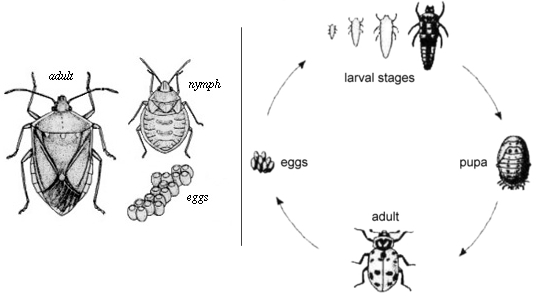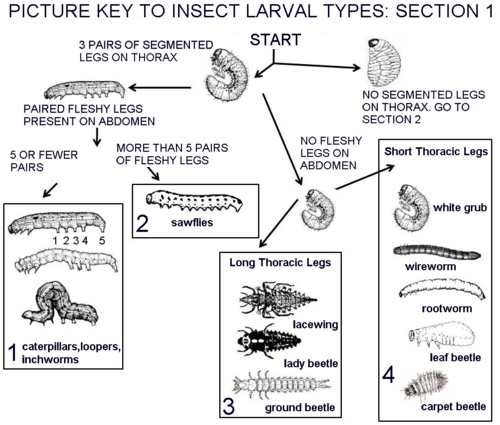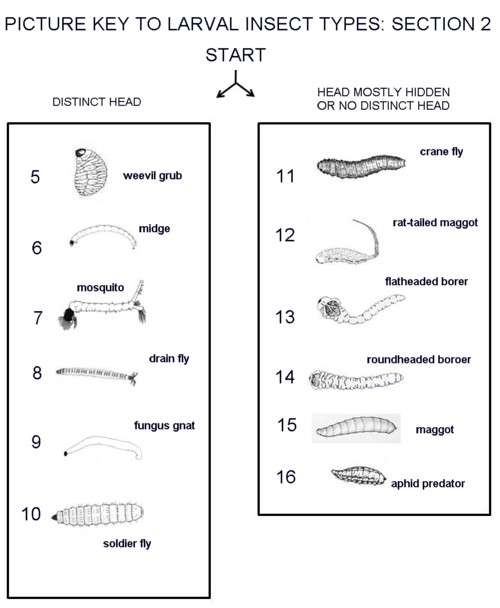Recognizing Insect Larval Types
ENTFACT-017: Recognizing Insect Larval Types | Download PDF
by Lee Townsend, Extension Entomologist
University of Kentucky College of Agriculture
Insects develop from egg to adult in a process called metamorphosis which may be generally classified as either gradual or complete. Gradual metamorphosis has three stages – egg, nymph, and adult. Nymphs generally look much like their adult stage except for being smaller and lacking wings, if the species has winged adults. Common examples include stink bugs, grasshoppers, and cockroaches.
About 75% of all insect species go through the four stages of complete metamorphosis - egg, larva, pupa, and adult. The larva is a specialized feeding stage that looks very different from the adult. Fortunately, there are just a few basic larval types and they are relatively easy to recognize. Often, insect identification must be based on the larval stage because no adults are present. Being able to recognize larval types can tell you a lot about the insect, For example, is it a plant feeder, predator, or a scavenger? Are any management or control practices necessary? This publication is designed to help you to follow a series of choices in a process to recognize the basic type of the insect that you have.
 Insect Metamorphosis: Gradual (left) and Complete (right)
Insect Metamorphosis: Gradual (left) and Complete (right)
Basic terms:
- Head – usually a dark, often hard capsule at front of body. It may be partly covered by the thorax. In some larvae, a hard or distinct head may be absent or completely hidden.
- Thorax – three segments immediately behind the head. A pair of segmented legs usually is attached to each. These segments may be fused together rather than being separate and distinct.
- Abdomen - eight to 10 body segments immediately following the thorax.
- Segmented thoracic legs – three pairs of segmented or
jointed legs that are found on the body segments immediately behind the head. - Fleshy legs- usually short, often paired, unsegmented extensions from the underside of the abdomen that are used for movement.
This key is like a path with a series of forks along the way. A choice is made at each fork that will send you toward an answer. The end point will be a drawing of one of the common larval types that should resemble your specimen.
Start- The first decision along the identification path is whether or not the larva has segmented thoracic legs. If it does, you stay on the first section of the key. If it does not, then go to the second page.
SECTION 1: Larvae with segmented thoracic legs and fleshy prolegs
Look at the abdomen for relatively distinct pairs of fleshy legs. Caterpillars (Order Lepidoptera) are immature stages of butterflies and moths; they have 5 or fewer pairs (Box 1). These plant feeders have chewing mouthparts. Often, caterpillars have “hairs”, spines, or distinct coloring. Those with 4 or fewer pairs of these legs are called “loopers” or “inchworms” because of the distinctive way that they crawl.
Larvae with pairs of fleshy legs on all abdominal segments (Box 2) are called sawflies (Order Hymenoptera). They often occur in groups on deciduous trees or evergreens.
Larvae with segmented thoracic legs but no fleshy prolegs
Larval types with segmented thoracic legs but no fleshy abdominal legs are shown in Boxes 3 and 4. These types are found in many species of beetles (Coleoptera) and some lacewings (Neuroptera) The decision at this point is more subjective. Larvae with relatively long thoracic legs and a relatively streamlined, often pointed bodies are shown in Box 3. These predators are active crawlers that hunt prey. Usually, they have a relatively flat heads and prominent forward-pointing jaws. Examples are a) lacewing, b) lady beetle, and c) ground beetle.
Larvae in Box 4 have shorter, thicker thoracic legs, a more box-shaped head, and wider abdomen. They can crawl but tend to be slow and deliberate. Soft, white bodied forms, like the white grub and rootworm, live in protected places while leaf feeders and scavengers tend to have harder, more protected bodies. White grubs (a) often occur in soil, decaying organic matter, rotting logs, etc. Wireworms (b) have hard, cylindrical, bodies. Many species live in soil feeding on seeds or roots or in decaying wood. Rootworm larvae (c) live in the soil and feed on plant roots. Leaf beetle larvae (d), like that of the Colorado potato beetle, resemble caterpillars without fleshy abdominal legs. They feed exposed on foliage. Hairy carpet beetle larva (e) are scavengers that feed on plant and animal products. They may be found in stored products or natural fibers, such as cotton or wool.

Picture Key to Larval Insect Types: Section 1 (click for larger picture)
SECTION 2: Larvae with no segmented thoracic legs
These are highly specialized larvae; most live in water, soil, wood, or in decaying organic matter. Some species have distinct, usually dark heads while others do not.
Legless larvae with distinct heads
Most of these larvae are beetles or flies (Diptera). Each of the pictures represents a larval type.
5 – Weevil grubs can be found in plants, plant tips, seeds, nuts, or with plant roots in the soil. The underside usually is flat while the upper side is rounded, giving them a humpbacked appearance.
6- Midge larvae occur in water or moist organic litter. There is a single fleshy leg at the front and back of the body. They are the immature stages of varies species of gnats.
7- Mosquito larvae (wiggler) are very distinctive. The thorax is wider than the abdomen and many species have a distinct air tube at the end of the abdomen. These larvae live in still water.
8 – Drain fly larva have narrow, strap-like plates across the upper surface. They live in standing,
stagnant water, and especially seldom used drains.
9 – Fungus gnat larvae resemble midge larvae but do not have fleshy legs. They live in moist, decaying
organic matter, especially accumulations of fallen leaves or dead grass.
10 – Soldier fly larva has a flat, gray, palm-shaped body with a distinct tapered head the protrudes from
the front. They are common in compost piles and decaying organic matter.
Head mostly hidden or no distinct head
These larvae either do not have distinct visible heads or the head is withdrawn almost completely into the thorax. They are fly larvae that with one exception live in wet or moist areas.
11 – Crane fly larvae often have fleshy lobes at end of their abdomens. The distinct head is completely hidden within the thorax. These dingy gray larvae live in decaying organic matter.
12 – Rat-tailed maggots have long distinct tails that are extensible breathing tubes which allow them to live in very stagnant water.
13 – Flatheaded wood borers have a distinct wide area behind their heads and a long white, soft body. The dark head is withdrawn into the thorax but part of it usually is visible. These borers live in tree limbs, branches, and stems.
14 – Roundheaded wood borers are similar to flatheaded borers but do not have the wide area behind the head.
15 – Fly maggots have no head and a cream to white body that is distinctly tapered at head and blunt at the rear. Many flies have this larval type including blow flies, house flies, and fruit flies.
16 – Aphid predator maggots are headless, they tend to have green tinged bodies and are found wandering on leaf surfaces where they feed on aphids. They are good crawlers and resemble small caterpillars but lack a distinct head and legs of any sort.

Picture Key to Larval Insect Types: Section 2 (click for larger picture)
There are thousands of variations of these basic forms but it is usually possible recognize its basic features and to place the specimen in one of the main groups. Help with larval identification is available thru your local Cooperative Extension office.
Life cycle drawings are from:
Virginia Tech - Department of Entomology
University of New Mexico - Entomology
Revised: 8/10
CAUTION! Pesticide recommendations in this publication are registered for use in Kentucky, USA ONLY! The use of some products may not be legal in your state or country. Please check with your local county agent or regulatory official before using any pesticide mentioned in this publication.
Of course, ALWAYS READ AND FOLLOW LABEL DIRECTIONS FOR SAFE USE OF ANY PESTICIDE!
Images: University of Kentucky Entomology, except where indicated
